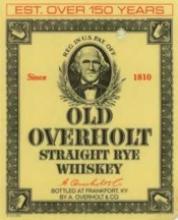When I set out to sample American Rye whiskey, I thought I'd probably be able to find three or four in a range of ages and prices. I knew that there were a number of smaller distilleries and even a few bottlers. Alas, after trying several local stores, I was only able to come up with two examples of American Rye. Old Overholt, and Jim Beam Straight Rye. I confess, that was more than a little disheartening; worse, though, was that I discovered both are now owned by a very large corporation Fortune Brands (they're big on spirits, and golf equipment) and both Old Overholt and Jim Beam Straight Rye are made by Jim Beam distillers. After hunting through several different liquor stores in vain and consulting with Rye-drinking friends on the East Coast, it became apparent that I would have to content myself with the limited choices available.
The PR person for the other large distiller of American Rye, Heaven Hills Brands, who make Rittenhouse and Pikesville Supreme Rye says here that "We spill more bourbon in a day than we sell rye in a year." Wild Turkey, who also makes a Rye, wasn't available locally either; there too, it's clear that Rye is still scarce. The master distiller at Wild Turkey says of their Rye that "It's not a real big seller, but it sells fairly well. We make it about three or four days a year." It's pretty easy to find Rye lovers writing about Rye, but neither Jim Beam nor Fortune Brands were terribly helpful in terms of Web sites; Rye for them seems to be very much a neglected child.
The Rye that seems most readily available in Puget Sound area liquor stores is Jim Beam Straight Rye, the so-called "yellow label" Rye; 40% ABV; 80 Proof. It's made in Kentucky, but it really is genuine American Straight Rye. In order to be labeled "straight," it has to have been barrel-aged in charred oak for two years or more. This was aged two years. It was a little sweet, with a bit less of the "peppery" flavor or spice not that Rye is known for. It's not unpleasant, but not as rounded or as interesting as Old Overholt—the other Rye whiskey I found to sample.
When I asked my Rye-drinking friends what to look for in terms of my first exposure to Rye, they suggested I start with Old Overholt. But upon going out shopping the first Rye we found was the Jim Beam yellow label. Luckily, I found the Old Overholt a day or so later, because if I hadn't been able to compare the two whiskeys, I'd have had a much less favorable impression of Rye, overall.
Old Overholt was a definite winner, and may have converted me entirely from ever using Bourbon in mixed drinks, again. It has that peppery-spicy note Rye should have—think of the distinct flavor or really good rye bread—with an underlying caramel, almost toasted-grain note. Smoother, overall, and extremely pleasant in any cocktail we mixed, I like it better not only in a Manhattan or an Old Fashioned, but neat or on the rocks. Given a choice, I'd definitely buy the Old Overholt again, but probably pass up the Jim Beam for a similarly-priced Bourbon, instead.
